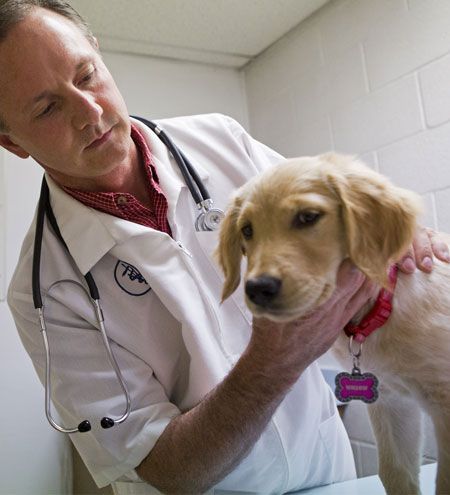Bound by debt: Veterinarians struggle with student loans in a tepid economy
Years after graduating, this Utah veterinarian is still in the grips of his student loan burden. But hope is on the horizon as he finally closes in on his dream of owning a practice.

Years after graduating, Utah veterinarian David Benson, DVM, still carries the burden of student loans.David Benson, DVM, hasn't taken a vacation with his family for five years. Like most veterinarians, he's spent his career so far juggling a hectic appointment schedule and difficult clients, and he's also helped his employers manage the practice staff and run the business with an eye toward eventually becoming a practice owner himself. That alone is enough to take a toll on the average individual. But Benson's challenges are made heavier by the presence of a sizeable chunk of student debt. "And it's not just veterinary school debt," he says. "When you factor in other living expenses and personal debt, it all adds up."
Since graduating in 1995, Benson has struggled to make ends meet and provide for his family. When he entered the job market, he knew the salary range he would need in order to make consistent payments on his loan, but he was also well aware that his starting salary would make it nearly impossible to purchase a home. "I was paid fairly well based on average salaries at the time, and I knew it would suffice while we were renting," he says. "But still, the debt was a lot to manage."
Benson is far from alone. The burden of managing student loan debt is becoming more and more commonplace in the veterinary profession these days, particularly with the rising cost of higher education. And the $53,000 Benson accrued during his education, which was fairly typical of veterinary student debt in the mid-90s, is a fraction of what many veterinary school graduates leave school with now. According to the American Veterinary Medical Association (AVMA), mean educational debt rose 6.5 percent from 2010 to 2011, coming in at a whopping $142,613. In the meantime, average full-time salaries for new graduates dropped 1.3 percent.
When he left school, Benson decided initially on a 10-year loan repayment schedule. But five years later, when he and his family were ready to purchase a home, they found they could no longer afford the high monthly payment. So he refinanced, extending his loan to a 20-year schedule, which dropped the monthly payments but also substantially compounded the long-term interest he would pay on the loan. And although his salary increased gradually over the years, it wasn't enough to offer much relief from his debt burden.
And Benson's debt has affected his career along with his personal finances. "Paying back my student loan affected my ability to purchase a practice," he says. "It delayed that process."

Benson is 17 years into paying down his student debt and is now able to purchase a practice.Tony Johnson, DVM, DACVECC, also has experience with student debt—both firsthand with his own loans and also through the veterinary students he interacts with on a daily basis. As an assistant clinical professor of emergency medicine at Purdue University College of Veterinary Medicine, Johnson sees the struggle his students face in terms of being financially bound to an educational loan. "For some of these students it's crippling," he says. "It's unfortunate that despite efforts by the colleges to explain the implications of the costs of going to veterinary school, many students don't seem to really understand the seriousness of the amount of debt they likely will incur and how they will service it—the actual nuts and bolts of what they're going to be paying out over time."
Johnson recognizes that some students don't even know their total loan amount after they've been approved, not to mention how much they're going to have to pay each month and how much interest they'll contribute to the overall capital over time. "I think this is certainly an area that schools could look more closely at and evaluate whether they are doing enough," he says. "But the schools face a real challenge due to the fact that the curriculum is so full of content that they are required to teach. They can't just 'add more', so there's no easy answer. "
Johnson also works with the Veterinary Information Network (VIN) and says that the organization is working on getting the word out to students about the burden of educational loans. "VIN offers debt repayment calculators and other financial planning tools on its website for students, but even that might not be enough," he says.
Although resources are available online for students through VIN and the AVMA, as well as the Association of American Veterinary Medical Colleges (AAVMC), it's less common to find counseling or resources at the colleges themselves—and particularly at the pre-veterinary education level, which is where it's needed most, in Benson's opinion. "Word isn't getting out to pre-vet students about debt," he says. "Many students I talk to or write letters of recommendation for don't know what's ahead."
Benson knows firsthand that one of the biggest pitfalls of educational loans is the lack of information students receive about the finanacial situation they're getting themselves into. "I knew how much debt I would be graduating with, but I didn't know what my monthly payments would be or how it would affect having a family or buying a house or practice," he says.
Benson believes that the solution to the increasing student debt dilemma is for veterinary schools and the AVMA to take a more active role in educating pre-veterinary students about assuming student loans. He says introducing a financial management course to the pre-veterinary curriculum would be a step in the right direction to help students plan ahead. "It's got to become a bigger priority of the AVMA and veterinary schools," Benson says. "They need to work on this together."
Johnson also sees how bleak the current financial situation is for veterinary graduates and knows it has the potential to only get worse—both for individuals and the profession as a whole. "If students come out of school and they're not able to service their loans, we're going to see individuals having a lot of financial hardship," he says. "They're going to be chained to this huge debt load. It's a serious threat not only to the financial health of the profession, but also to the overall viability of veterinary medicine as a career. This debt issue really has far-ranging implications."
Luckily for Dr. Benson, he's finally seeing a light at the end of his debt-darkened tunnel. Seventeen years into paying back his student loan, he and his family are in a more comfortable position—and he's now able to purchase a practice. In July, Benson became the new owner of West Lake Animal Hospital in Taylorsville, Utah.
Although the current economic climate does leave him feeling apprehensive about the prospect of owning his own practice, there's certainly hope that the future holds promise for his family's financial security.